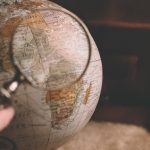Indeed, over the last decades there has been a lot of progress in closing the gender gap in Africa. But, there is still a lot of work to do. In the World Economic Forum’s Gender Gap Report (WEF GGGR), The AEF team found that many African countries rank behind in terms of gender parity. This, we believe, is strongly due to challenges such as female educational attainment and workforce participation.
Over the next few weeks, we will be taking a closer look at the progress of #ourwomen in Ethiopia, Ghana and Zimbabwe.
The bubble chart below illustrates the respective country’s average GGGR ranking in relation to their average GDP growth rate in percentage (2015 – 2018). The scale of the bubble represents the female population size.

